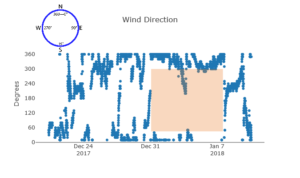For a while in December and a bit of January, many Bay residents were asking, “where did all the water go?” During the cold spell the region experienced, many residents noticed low water levels lasting for a while. Some worried that the low tides would kill oyster populations exposed to the cold air above.
Virginia Institute of Marine Science (VIMS) scientist Dr. John Boon helped explain the prolonged low tide: “We’re near the low in the seasonal cycle right now because it’s winter and water contracts when it’s colder.” He added that regular monthly variation in the positioning of the Earth, moon, and sun could also be affecting the tides.

“NOAA’s York River data buoy and other locations around Chesapeake Bay experienced persistent northerly winds during late December and early January. Northery winds blow from 0 or 360 degrees. Note the absence of winds from other directions between December 31 and January 8th (orange rectangle).” Source
An even more significant contributor to the low water levels are northerly winds that have been pushing water out of the Bay. Data from NOAA’s York River buoy showed that between December 30th and January 7th, winds blew from the north to the south almost the entire time.
Another VIMS scientist, Dr. Carl “Woody” Hobbs, noted that high barometric pressure probably also contributed to low water levels. He explained that clear, cold weather often takes place at the same time as high pressure systems.
Evidence has grown that climate change could be contributing to winter storms, like the one the East coast recently experienced. As the Arctic warms, the temperature difference between polar and temperate areas declines, decreasing the strength of the jet stream. That means that cold air masses can travel farther into mid-latitude areas, causing the weather the Bay experienced throughout December and into January.
